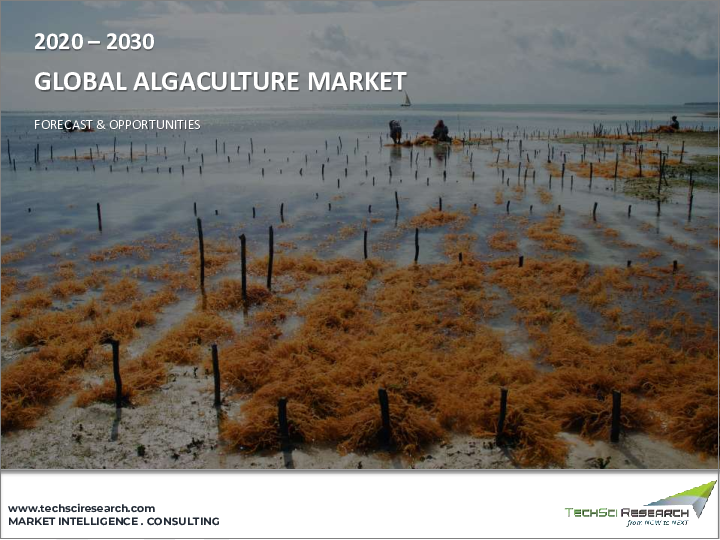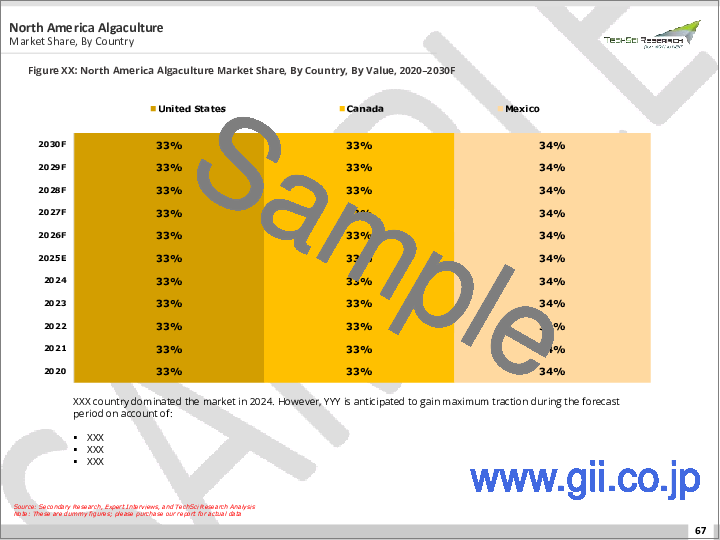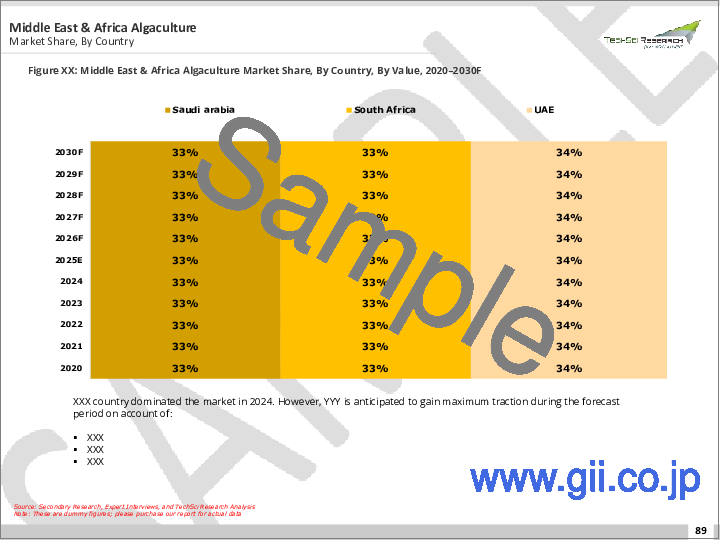|
|
市場調査レポート
商品コード
1692258
藻類培養市場- 世界の産業規模、シェア、動向、機会、予測、藻類の種類別、技術別、用途別、地域別、競合別、2020-2030年Algaculture Market - Global Industry Size, Share, Trends, Opportunity, and Forecast, Segmented By Type of Algae, By Technique, By Application, By Region and Competition, 2020-2030F |
||||||
カスタマイズ可能
|
|||||||
| 藻類培養市場- 世界の産業規模、シェア、動向、機会、予測、藻類の種類別、技術別、用途別、地域別、競合別、2020-2030年 |
|
出版日: 2025年03月24日
発行: TechSci Research
ページ情報: 英文 185 Pages
納期: 2~3営業日
|
全表示
- 概要
- 目次
藻類培養の世界市場は、2024年に211億4,000万米ドルと評価され、予測期間中のCAGRは6.50%で、2030年には308億4,000万米ドルに達すると予測されています。
藻類培養は水産養殖の一形態であり、様々な目的のために藻類の種を培養します。培養藻類の大部分は微細藻類であり、植物プランクトンまたは浮遊性藻類としても知られています。これらの微細藻類は、廃水からの栄養除去、大気からのCO2吸収、バイオ燃料生産の原料など、複数の機能を果たします。また、人間や動物の食料源としても利用されています。藻類培養市場は、特に藻の商業生産に焦点を当てており、バイオ燃料、食品・飼料、栄養補助食品、バイオプラスチックなど多様な分野で応用されています。この産業は、その環境の持続可能性と藻類の幅広い用途により急速な成長を遂げています。継続的な技術の進歩と継続的な調査により、藻類市場は近い将来新たな高みに到達するものと思われます。
| 市場概要 | |
|---|---|
| 予測期間 | 2026-2030 |
| 市場規模:2024年 | 211億4,000万米ドル |
| 市場規模:2030年 | 308億4,000万米ドル |
| CAGR:2025年~2030年 | 6.50% |
| 急成長セグメント | 微細藻類 |
| 最大市場 | アジア太平洋 |
市場促進要因
藻類ベースのバイオ燃料需要の増加
主な市場課題
高額な初期投資
主要市場動向
藻類培養技術の進歩
目次
第1章 概要
第2章 調査手法
第3章 エグゼクティブサマリー
第4章 世界の藻類培養市場展望
- 市場規模・予測
- 金額別
- 市場シェア・予測
- 藻類の種類別(微細藻類と大型藻類)
- 技術別(単一培養、混合培養、連続希釈、その他)
- 用途別(肥料、飼料、食品着色料、医薬品、その他)
- 地域別
- 企業別(2024)
- 市場マップ
第5章 北米の藻類培養市場展望
- 市場規模・予測
- 金額別
- 市場シェア・予測
- 藻類の種類別
- 技術別
- 用途別
- 国別
- 北米:国別分析
- 米国
- カナダ
- メキシコ
第6章 欧州の藻類培養市場展望
- 市場規模・予測
- 市場シェア・予測
- 欧州:国別分析
- ドイツ
- 英国
- イタリア
- フランス
- スペイン
第7章 アジア太平洋地域の藻類培養市場展望
- 市場規模・予測
- 市場シェア・予測
- アジア太平洋地域:国別分析
- 中国
- インド
- 日本
- 韓国
- オーストラリア
第8章 南米の藻類培養市場展望
- 市場規模・予測
- 市場シェア・予測
- 南米:国別分析
- ブラジル
- アルゼンチン
- コロンビア
第9章 中東・アフリカの藻類培養市場展望
- 市場規模・予測
- 市場シェア・予測
- 中東・アフリカ:国別分析
- 南アフリカ
- サウジアラビア
- アラブ首長国連邦
第10章 市場力学
- 促進要因
- 課題
第11章 市場動向と発展
- 最近の動向
- 合併と買収
- 製品上市
第12章 世界の藻類培養市場:SWOT分析
第13章 ポーターのファイブフォース分析
- 業界内の競合
- 新規参入の可能性
- サプライヤーの力
- 顧客の力
- 代替品の脅威
第14章 競合情勢
- Marigan Holding B.V.
- Prolgae Spirulina Supplies Pvt. Ltd.
- Swedish Algae Factory Ab
- Monzon Biotech S.L.
- Algatech Ltd.
- TerraVia Holdings, Inc.
- Harris Group
- Algae Systems, LLC.
- DIC Corporation
- Cargill, Incorporated.
第15章 戦略的提言
第16章 調査会社について・免責事項
Global Algaculture Market was valued at USD 21.14 billion in 2024 and is expected to reach USD 30.84 billion by 2030 with a CAGR of 6.50% during the forecast period. Algaculture, a form of aquaculture, involves the cultivation of algae species for various purposes. The majority of cultivated algae are microalgae, also known as phytoplankton or planktonic algae. These microalgae serve multiple functions, such as nutrient removal from wastewater, CO2 absorption from the atmosphere, and serving as a raw material for biofuel production. Additionally, they can be utilized as a source of food for both humans and animals. The Algaculture Market specifically focuses on the commercial production of algae, which finds applications in diverse sectors including biofuel, food and feed, nutraceuticals, and bioplastics. This industry has witnessed rapid growth due to its environmental sustainability and the wide range of algae applications. With continuous technological advancements and ongoing research, the Algaculture Market is poised to reach new heights in the foreseeable future.
| Market Overview | |
|---|---|
| Forecast Period | 2026-2030 |
| Market Size 2024 | USD 21.14 Billion |
| Market Size 2030 | USD 30.84 Billion |
| CAGR 2025-2030 | 6.50% |
| Fastest Growing Segment | Microalgae |
| Largest Market | Asia Pacific |
Key Market Drivers
Increasing Demand for Algae-Based Biofuels
The burgeoning popularity of algae-based biofuels is projected to significantly boost global demand for algaculture in the coming years. Algae, with its inherent capability to produce high-quality biofuels and capture carbon dioxide, has emerged as a viable alternative to fossil fuels. Algae-based biofuels, unlike traditional biofuels derived from energy crops such as corn or sugarcane, do not compete with food production for arable land. This sustainable, non-food biofuel source benefits from a proliferating awareness about its potential in curtailing greenhouse gas emissions. Additionally, technological advancements in algaculture, including the development of more efficient and scalable production systems, are also driving this surge in demand. The global shift towards renewable energy, propelled by environmental concerns and government incentives, is anticipated to further accelerate the expansion of the algaculture industry worldwide. As countries worldwide strive to lower their carbon emissions and diversify their energy sources, the cultivation of algae for biofuels is expected to flourish.
Key Market Challenges
High Initial Investment
High initial investment is a significant deterrent to the global demand for Algaculture. As an emerging industry, Algaculture requires substantial capital outlay in its initial stages for the procurement of high-tech equipment, advanced machinery, and training of personnel. The cost of bioreactors, particularly those needed for large-scale commercial production, is exceedingly high. Furthermore, the establishment of processing facilities for converting raw algae into finished products necessitates an additional substantial investment. These high costs can be prohibitive for many potential investors, particularly those in developing countries where capital is often scarce. Additionally, the return on investment (ROI) is not immediate, as it takes time to establish production processes, stabilize output, and secure market acceptance. Therefore, the high initial investment required in Algaculture is expected to curtail its global demand, as prospective investors may be deterred by the significant financial risks involved.
Key Market Trends
Advancements in Algaculture Technologies
Advancements in algaculture technologies are predicted to significantly drive the global demand for algaculture, accelerating the growth of this innovative sector. New technologies are making it feasible to cultivate various forms of algae on a large scale, which was previously a major challenge. These developments are not only increasing yield but also improving the efficiency and sustainability of algaculture operations.
Sophisticated harvesting and processing technologies have improved the quality of algae-based products, making them competitive and appealing to a wider range of industries. From health supplements to biofuel, the versatile use of algae has opened up new markets, thereby fueling demand. Additionally, as global awareness of environmental sustainability grows, the low carbon footprint of algaculture compared to traditional agriculture increases its attractiveness. With the world seeking cleaner, renewable sources of energy and healthier, more sustainable food options, algaculture, powered by advancing technologies, is poised to meet these needs. Thus, it is not surprising that the global demand for algaculture is expected to rise exponentially in the coming years.
Key Market Players
- Marigan Holding B.V.
- Prolgae Spirulina Supplies Pvt. Ltd.
- Swedish Algae Factory Ab
- Monzon Biotech S.L.
- Algatech Ltd.
- TerraVia Holdings, Inc.
- Harris Group
- Algae Systems, LLC.
- DIC Corporation
- Cargill, Incorporated.
Report Scope:
In this report, the Global Algaculture Market has been segmented into the following categories, in addition to the industry trends which have also been detailed below:
Algaculture Market, By Type of Algae:
- Microalgae
- Macroalgae
Algaculture Market, By Technique:
- Monoculture
- Mixed Culture
- Serial Dilution
- Others
Algaculture Market, By Application:
- Fertilizers
- Feed
- Food Colouring
- Pharmaceuticals
- Others
Algaculture Market, By Region:
- North America
- United States
- Canada
- Mexico
- Europe
- France
- United Kingdom
- Italy
- Germany
- Spain
- Asia-Pacific
- China
- India
- Japan
- Australia
- South Korea
- South America
- Brazil
- Argentina
- Colombia
- Middle East & Africa
- South Africa
- Saudi Arabia
- UAE
Competitive Landscape
Company Profiles: Detailed analysis of the major companies present in the Global Algaculture Market.
Available Customizations:
Global Algaculture market report with the given market data, TechSci Research offers customizations according to a company's specific needs. The following customization options are available for the report:
Company Information
- Detailed analysis and profiling of additional market players (up to five).
Table of Contents
1. Product Overview
- 1.1. Market Definition
- 1.2. Scope of the Market
- 1.2.1. Markets Covered
- 1.2.2. Years Considered for Study
- 1.2.3. Key Market Segmentations
2. Research Methodology
- 2.1. Objective of the Study
- 2.2. Baseline Methodology
- 2.3. Key Industry Partners
- 2.4. Major Association and Secondary Sources
- 2.5. Forecasting Methodology
- 2.6. Data Triangulation & Validations
- 2.7. Assumptions and Limitations
3. Executive Summary
- 3.1. Overview of the Market
- 3.2. Overview of Key Market Segmentations
- 3.3. Overview of Key Market Players
- 3.4. Overview of Key Regions/Countries
- 3.5. Overview of Market Drivers, Challenges, Trends
- 3.6. Voice of Customer
4. Global Algaculture Market Outlook
- 4.1. Market Size & Forecast
- 4.1.1. By Value
- 4.2. Market Share & Forecast
- 4.2.1. By Type of Algae (Microalgae and Macroalgae)
- 4.2.2. By Technique (Monoculture, Mixed Culture, Serial Dilution, Others)
- 4.2.3. By Application (Fertilizers, Feed, Food Colouring, Pharmaceuticals, Others)
- 4.2.4. By Region
- 4.2.5. By Company (2024)
- 4.3. Market Map
5. North America Algaculture Market Outlook
- 5.1. Market Size & Forecast
- 5.1.1. By Value
- 5.2. Market Share & Forecast
- 5.2.1. By Type of Algae
- 5.2.2. By Technique
- 5.2.3. By Application
- 5.2.4. By Country
- 5.3. North America: Country Analysis
- 5.3.1. United States Algaculture Market Outlook
- 5.3.1.1. Market Size & Forecast
- 5.3.1.1.1. By Value
- 5.3.1.2. Market Share & Forecast
- 5.3.1.2.1. By Type of Algae
- 5.3.1.2.2. By Technique
- 5.3.1.2.3. By Application
- 5.3.1.1. Market Size & Forecast
- 5.3.2. Canada Algaculture Market Outlook
- 5.3.2.1. Market Size & Forecast
- 5.3.2.1.1. By Value
- 5.3.2.2. Market Share & Forecast
- 5.3.2.2.1. By Type of Algae
- 5.3.2.2.2. By Technique
- 5.3.2.2.3. By Application
- 5.3.2.1. Market Size & Forecast
- 5.3.3. Mexico Algaculture Market Outlook
- 5.3.3.1. Market Size & Forecast
- 5.3.3.1.1. By Value
- 5.3.3.2. Market Share & Forecast
- 5.3.3.2.1. By Type of Algae
- 5.3.3.2.2. By Technique
- 5.3.3.2.3. By Application
- 5.3.3.1. Market Size & Forecast
- 5.3.1. United States Algaculture Market Outlook
6. Europe Algaculture Market Outlook
- 6.1. Market Size & Forecast
- 6.1.1. By Value
- 6.2. Market Share & Forecast
- 6.2.1. By Type of Algae
- 6.2.2. By Technique
- 6.2.3. By Application
- 6.2.4. By Country
- 6.3. Europe: Country Analysis
- 6.3.1. Germany Algaculture Market Outlook
- 6.3.1.1. Market Size & Forecast
- 6.3.1.1.1. By Value
- 6.3.1.2. Market Share & Forecast
- 6.3.1.2.1. By Type of Algae
- 6.3.1.2.2. By Technique
- 6.3.1.2.3. By Application
- 6.3.1.1. Market Size & Forecast
- 6.3.2. United Kingdom Algaculture Market Outlook
- 6.3.2.1. Market Size & Forecast
- 6.3.2.1.1. By Value
- 6.3.2.2. Market Share & Forecast
- 6.3.2.2.1. By Type of Algae
- 6.3.2.2.2. By Technique
- 6.3.2.2.3. By Application
- 6.3.2.1. Market Size & Forecast
- 6.3.3. Italy Algaculture Market Outlook
- 6.3.3.1. Market Size & Forecast
- 6.3.3.1.1. By Value
- 6.3.3.2. Market Share & Forecasty
- 6.3.3.2.1. By Type of Algae
- 6.3.3.2.2. By Technique
- 6.3.3.2.3. By Application
- 6.3.3.1. Market Size & Forecast
- 6.3.4. France Algaculture Market Outlook
- 6.3.4.1. Market Size & Forecast
- 6.3.4.1.1. By Value
- 6.3.4.2. Market Share & Forecast
- 6.3.4.2.1. By Type of Algae
- 6.3.4.2.2. By Technique
- 6.3.4.2.3. By Application
- 6.3.4.1. Market Size & Forecast
- 6.3.5. Spain Algaculture Market Outlook
- 6.3.5.1. Market Size & Forecast
- 6.3.5.1.1. By Value
- 6.3.5.2. Market Share & Forecast
- 6.3.5.2.1. By Type of Algae
- 6.3.5.2.2. By Technique
- 6.3.5.2.3. By Application
- 6.3.5.1. Market Size & Forecast
- 6.3.1. Germany Algaculture Market Outlook
7. Asia-Pacific Algaculture Market Outlook
- 7.1. Market Size & Forecast
- 7.1.1. By Value
- 7.2. Market Share & Forecast
- 7.2.1. By Type of Algae
- 7.2.2. By Technique
- 7.2.3. By Application
- 7.2.4. By Country
- 7.3. Asia-Pacific: Country Analysis
- 7.3.1. China Algaculture Market Outlook
- 7.3.1.1. Market Size & Forecast
- 7.3.1.1.1. By Value
- 7.3.1.2. Market Share & Forecast
- 7.3.1.2.1. By Type of Algae
- 7.3.1.2.2. By Technique
- 7.3.1.2.3. By Application
- 7.3.1.1. Market Size & Forecast
- 7.3.2. India Algaculture Market Outlook
- 7.3.2.1. Market Size & Forecast
- 7.3.2.1.1. By Value
- 7.3.2.2. Market Share & Forecast
- 7.3.2.2.1. By Type of Algae
- 7.3.2.2.2. By Technique
- 7.3.2.2.3. By Application
- 7.3.2.1. Market Size & Forecast
- 7.3.3. Japan Algaculture Market Outlook
- 7.3.3.1. Market Size & Forecast
- 7.3.3.1.1. By Value
- 7.3.3.2. Market Share & Forecast
- 7.3.3.2.1. By Type of Algae
- 7.3.3.2.2. By Technique
- 7.3.3.2.3. By Application
- 7.3.3.1. Market Size & Forecast
- 7.3.4. South Korea Algaculture Market Outlook
- 7.3.4.1. Market Size & Forecast
- 7.3.4.1.1. By Value
- 7.3.4.2. Market Share & Forecast
- 7.3.4.2.1. By Type of Algae
- 7.3.4.2.2. By Technique
- 7.3.4.2.3. By Application
- 7.3.4.1. Market Size & Forecast
- 7.3.5. Australia Algaculture Market Outlook
- 7.3.5.1. Market Size & Forecast
- 7.3.5.1.1. By Value
- 7.3.5.2. Market Share & Forecast
- 7.3.5.2.1. By Type of Algae
- 7.3.5.2.2. By Technique
- 7.3.5.2.3. By Application
- 7.3.5.1. Market Size & Forecast
- 7.3.1. China Algaculture Market Outlook
8. South America Algaculture Market Outlook
- 8.1. Market Size & Forecast
- 8.1.1. By Value
- 8.2. Market Share & Forecast
- 8.2.1. By Type of Algae
- 8.2.2. By Technique
- 8.2.3. By Application
- 8.2.4. By Country
- 8.3. South America: Country Analysis
- 8.3.1. Brazil Algaculture Market Outlook
- 8.3.1.1. Market Size & Forecast
- 8.3.1.1.1. By Value
- 8.3.1.2. Market Share & Forecast
- 8.3.1.2.1. By Type of Algae
- 8.3.1.2.2. By Technique
- 8.3.1.2.3. By Application
- 8.3.1.1. Market Size & Forecast
- 8.3.2. Argentina Algaculture Market Outlook
- 8.3.2.1. Market Size & Forecast
- 8.3.2.1.1. By Value
- 8.3.2.2. Market Share & Forecast
- 8.3.2.2.1. By Type of Algae
- 8.3.2.2.2. By Technique
- 8.3.2.2.3. By Application
- 8.3.2.1. Market Size & Forecast
- 8.3.3. Colombia Algaculture Market Outlook
- 8.3.3.1. Market Size & Forecast
- 8.3.3.1.1. By Value
- 8.3.3.2. Market Share & Forecast
- 8.3.3.2.1. By Type of Algae
- 8.3.3.2.2. By Technique
- 8.3.3.2.3. By Application
- 8.3.3.1. Market Size & Forecast
- 8.3.1. Brazil Algaculture Market Outlook
9. Middle East and Africa Algaculture Market Outlook
- 9.1. Market Size & Forecast
- 9.1.1. By Value
- 9.2. Market Share & Forecast
- 9.2.1. By Type of Algae
- 9.2.2. By Technique
- 9.2.3. By Application
- 9.2.4. By Country
- 9.3. MEA: Country Analysis
- 9.3.1. South Africa Algaculture Market Outlook
- 9.3.1.1. Market Size & Forecast
- 9.3.1.1.1. By Value
- 9.3.1.2. Market Share & Forecast
- 9.3.1.2.1. By Type of Algae
- 9.3.1.2.2. By Technique
- 9.3.1.2.3. By Application
- 9.3.1.1. Market Size & Forecast
- 9.3.2. Saudi Arabia Algaculture Market Outlook
- 9.3.2.1. Market Size & Forecast
- 9.3.2.1.1. By Value
- 9.3.2.2. Market Share & Forecast
- 9.3.2.2.1. By Type of Algae
- 9.3.2.2.2. By Technique
- 9.3.2.2.3. By Application
- 9.3.2.1. Market Size & Forecast
- 9.3.3. UAE Algaculture Market Outlook
- 9.3.3.1. Market Size & Forecast
- 9.3.3.1.1. By Value
- 9.3.3.2. Market Share & Forecast
- 9.3.3.2.1. By Type of Algae
- 9.3.3.2.2. By Technique
- 9.3.3.2.3. By Application
- 9.3.3.1. Market Size & Forecast
- 9.3.1. South Africa Algaculture Market Outlook
10. Market Dynamics
- 10.1. Drivers
- 10.2. Challenges
11. Market Trends & Developments
- 11.1. Recent Development
- 11.2. Mergers & Acquisitions
- 11.3. Product Launches
12. Global Algaculture Market: SWOT Analysis
13. Porter's Five Forces Analysis
- 13.1. Competition in the Industry
- 13.2. Potential of New Entrants
- 13.3. Power of Suppliers
- 13.4. Power of Customers
- 13.5. Threat of Substitute Products
14. Competitive Landscape
- 14.1. Marigan Holding B.V.
- 14.1.1. Business Overview
- 14.1.2. Company Snapshot
- 14.1.3. Product & Service Offerings
- 14.1.4. Financials (As Reported)
- 14.1.5. Recent Developments
- 14.1.6. Key Personnel Details
- 14.1.7. SWOT Analysis
- 14.2. Prolgae Spirulina Supplies Pvt. Ltd.
- 14.3. Swedish Algae Factory Ab
- 14.4. Monzon Biotech S.L.
- 14.5. Algatech Ltd.
- 14.6. TerraVia Holdings, Inc.
- 14.7. Harris Group
- 14.8. Algae Systems, LLC.
- 14.9. DIC Corporation
- 14.10. Cargill, Incorporated.




